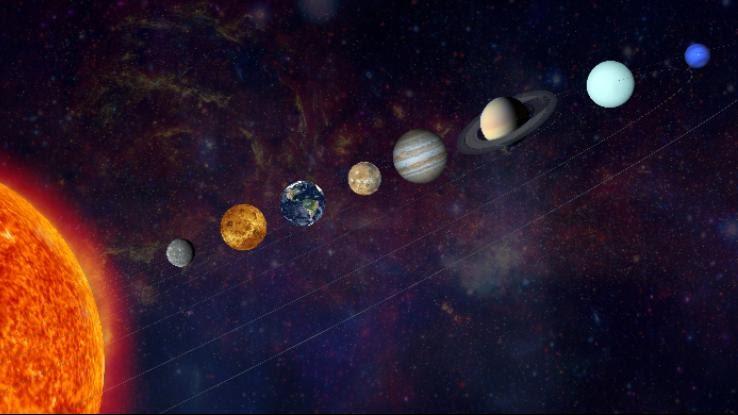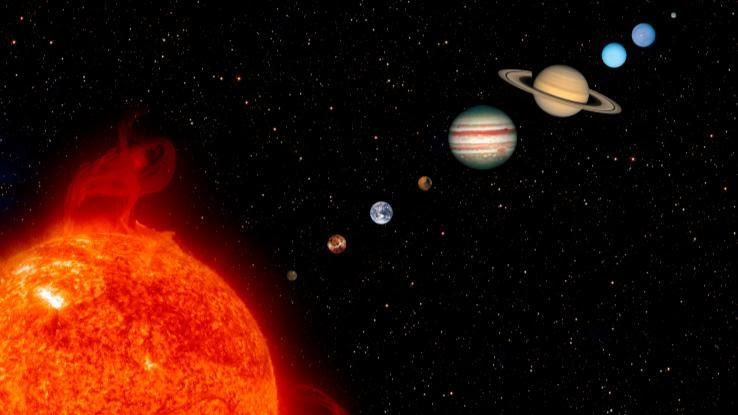Rhymes to Remember the Order of the Planets

Children learn about the planets in the solar system at a young age. Usually, they memorize the order of the planets by reciting a fun rhyme. For years, one of the most popular rhymes was “My Very Educated Mother Just Served Us Nine Pizzas.” Then, in 2006, the phrase was adjusted to “My Very Educated Mother Just Served Us Nachos” after Pluto was classified as a dwarf planet and removed from the roster of official planets.
While the idea of a delicious dinner may be appealing and memorable, there are numerous other rhymes you can choose from that’ll help you teach children to memorize the order of the planets. There’s a wide selection of mnemonic phrases that can also be useful. But which are the best for assisting with thorough memorization? Review these examples and lesson plans for helping children to remember all of the planets.
Planets in Order From the Sun
Both children and adults are fascinated by the planets in the solar system. Every planet is unique and has different characteristics. Starting nearest to the Sun and moving farther away, the order is Mercury, Venus, Earth, Mars, Jupiter, Saturn, Uranus and Neptune. Before the International Astronomical Union removed Pluto as a planet in 2006, Pluto followed Neptune in the list.

The inner four planets (Mercury, Venus, Earth and Mars) are classified as “terrestrial planets” because they have rocky surfaces. They’re separated by the asteroid belt, which is a region of solid asteroids in the solar system located between Mars and Jupiter.
The inner planets differ from the outer four planets — Jupiter, Saturn, Uranus and Neptune — which are known as “gas planets” because they consist of hydrogen, helium and ammonia gases. Jupiter and Saturn are referred to as “gas giants,” while Uranus and Neptune are “ice giants” because, while they’re gas planets, they consist of more atmospheric water and ice-forming molecules — including methane, hydrogen sulfide and phosphene — than other planets.
Basic Characteristics of the Planets
While it’s important to learn the order of the planets, it’s also helpful to know some basic facts about and characteristics of each planet. Learning this material can help students understand the differences and reinforce scientific concepts. Below are some general facts about the planets that children can benefit from learning:

Mercury: The closest planet to the Sun, Mercury’s orbital revolution around the Sun only lasts 88 Earth days. Also the smallest planet in the solar system (only slightly larger than Earth’s moon), it experiences extreme changes in night and day temperatures.
Venus: Known as Earth’s twin, Venus is relatively the same size as Earth and has mountains and volcanoes. Its orbital revolution lasts 225 Earth days. The planet has a thick, toxic atmosphere due to sulfuric acid clouds, making it a greenhouse planet. Venus rotates from east to west, contrasting with most other planets in the solar system.
Earth: The only known habitable planet in the solar system, Earth is a water world, making it suitable for human life. It’s our home planet.
Mars: Nicknamed “The Red Planet,” Mars has a desert-like surface. The planet’s dust is made of iron oxides, which give Mars its signature red hue. Its orbital revolution lasts 687 Earth days. Because Mars is somewhat similar to Earth (with mountains, valleys and canyons), scientists believe Mars may one day be able to support human life. In July 2018, scientists discovered evidence of a liquid lake on the planet’s surface.
Jupiter: The largest planet in the solar system, Jupiter is a gas planet that’s more than twice as large as the other planets combined. With an orbital rotation lasting over 11 Earth years, the planet has swirling clouds, including its famous Great Red Spot. Finally, Jupiter has 75 revolving moons, making it seem like its own solar system.
Saturn: Saturn is the planet with rings. These rings consist of ice and rock, making the planet more unique than others. Saturn’s orbital revolution also lasts over 29 Earth years.
Uranus: Another unique planet, Uranus rotates from east to west like Venus. The planet’s orbital rotation lasts 84 Earth years. The equator is at right angles to the planet’s orbit, meaning Uranus orbits on its side. It’s estimated that another planet once collided with Uranus, causing it to tilt.
Neptune: The planet is known for having violent windstorms. With an orbital rotation of 165 Earth years, Neptune was the only planet discovered via astronomy mathematics before it was detected by telescopes and satellites.
The planets are fascinating and can be easy to remember with the aid of fun rhymes and sayings. Which ones should you use to get started?
Mnemonics for Planets
There are numerous rhymes that help people learn the order of the planets. For example, children can learn to recite a rhyme to remember the planets in order:

Mercury is closest to the Sun.
Hot, hot Venus is the second one.
Earth comes third; it’s not too hot.
Freezing Mars awaits an astronaut.
Jupiter is bigger than all the rest.
Sixth comes Saturn; its rings look best.
Uranus and Neptune are big gas balls.
Tiny Pluto is the last planet of all.
Other rhymes use mnemonics (a pattern of letters to help with memorization) and acronyms to teach the order of the planets. For instance, and as mentioned above, “My (Mercury) Very (Venus) Educated (Earth) Mother (Mars) Just (Jupiter) Served (Saturn) Us (Uranus) Nine (Neptune) Pizzas (Pluto)” uses the first letter of each planet’s name but replaces the names of the planets with common words for children to recognize. Similar mnemonic devices include “Many Very Elderly Monsters Just Snooze Under Newspapers,” “My Vicious Earthworm Might Just Swallow Us Now” and “Mother Veronica Enjoyed My Jam Under Neptune.” Just remember that every word in the rhyme or saying starts with the first letter of each planet in order. If a child is having trouble remembering which “M” planet is first in the solar system, teach them that they can’t put a Mars chocolate bar right next to the Sun. It would melt, so Mercury is first.
Other ways to memorize the order of the planets include listening to planet songs, using visual pictures of the planets or flashcards, building a three-dimensional model of the solar system, and assigning children to create their own mnemonic devices and rhymes for the planets.
These tips are a starting point for children to not only learn the order of the planets at a young age but to remember them as they grow older. They’re catchy phrases that’ll stay with people of all ages for a long period of time, too.





